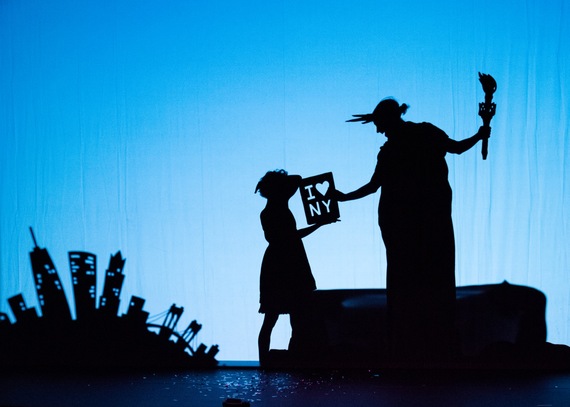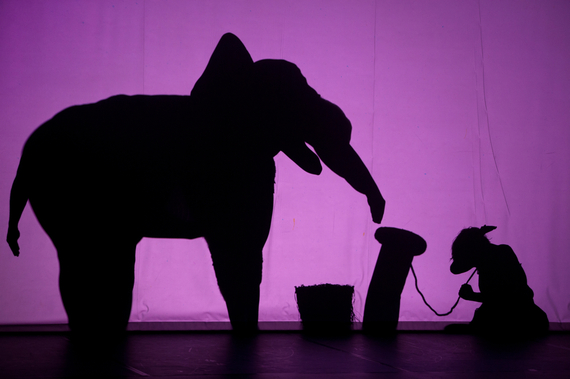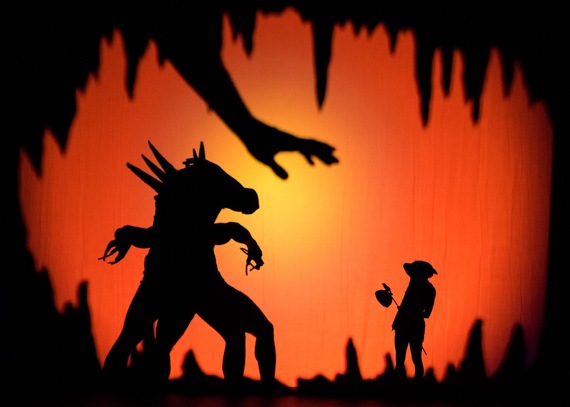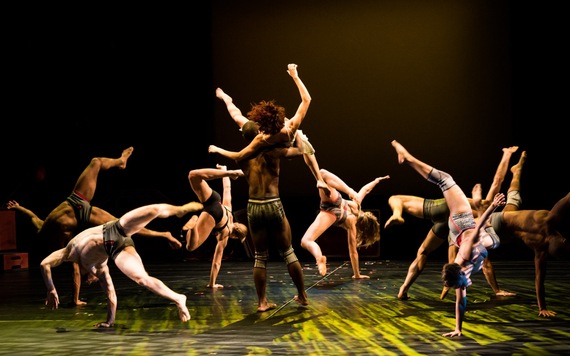Photo credit: Ian Douglas.
We all have something to hide.
Usually, we bury it deep inside the caverns of ourselves, where no one can find it. It's a secret, a wild whisper so engrained that we can't dismiss it.
It's our shadow. And it follows us everywhere.
Pilobolus' 2009 show Shadowland made its U.S. debut at the NYU Skirball Center this holiday season. Shadowland is like reading a fable -- a good one -- when you desperately want to know what comes next and your heart is pumping at 100 miles an hour even though you can practically spell out the ending. It's like the Little Mermaid, Sleeping Beauty, and Alice in Wonderland, with some of the darkness and grit of the pre-Brothers Grimm versions. The plot -- a bildungsroman set in the fantasy of a foreign universe -- centers around a teenage girl and her demons, the shadows she hides inside. Bodies intermingle behind a screen as surrealist shapes form crabs, and cars, and monsters, and men. Even the protagonist has a metamorphosis as she transforms into a half-human, half-dog, her ears flapping backwards in lonely sadness.

Pilobolus' encore was a tribute to New York City, celebrating Shadowland's debut in the United States. Photo credit: Ian Douglas.
Pilobolus is known for its illusions. Though Dartmouth alumni founded the dance company in 1971, it broke out into mainstream culture in 2007 with a Hyundai commercial and a cameo at the Academy Awards Ceremony. Now, collaborators Steven Banks, Robby Barnett, Renee Jaworski, Matt Kent, Itamar Kubovy, and Michael Tracy have created an evening-length work of shape-shifting behind a scrim, so that what you see is part dance, part film-like narrative, part pop-out fairytale. Of course, the screen itself is not a permanent fixture; at moments, you're at a circus with "freaks" on parade, their eyes in the line of visibility. Another instance finds the heroine in a trio, where two men represent a centaur, her lover. Still, the majority of the production takes place in this Shadowland that is separate but immediate to the viewer. David Poe's score adds mystery and majesty to the landscape, like a tinkling jewelry box that strums just barely offbeat.
There was something voyeuristic about Shadowland, like you were watching a girl's nightmares materialize. You had a safe distance from them, but she didn't, and for that you felt sorry. But really you weren't so sorry, because it was beautiful to see her come of age and begin to accept herself without shying from the uglier parts of her imagination.
Photo credit: Ian Douglas.
The trio was an especially striking scene, as it represented love and carnal and spiritual pleasure. Women ran like nymphs across the stage, lifting the girl (portrayed by Heather Jeane Favretto) out of her clothing, artificial bonds that isolated her from nature. Then, everyone was topless, but the mood didn't seem sensual or even sexy. Instead, it was magical and exploratory, like you were discovering a whole new world along with this young woman and her centaur-friend. Like you and they were learning what it meant to relate.
Shadowland's only fault was its predictability. It grew tiresome after you realized you knew where your protagonist would end up because the story followed so many canonical examples. Once again, this was all just play. Like most narratives that challenge "reality," it was a dream, innocent and benign. The teen would awake, and she would hug her parents, and she would live happily ever after in puberty. But why is it that we demand our fairytales finish in happily ever after when another conclusion could mean so much more?

Photo credit: Emmanuel Donny.
Still, the show has a message beyond clichés and entertainment. Those demons we hide inside our shadows, the ones we hope no one else sees -- maybe they're not so bad after all. We just have to accept them and learn how they can be used for good. They may taste bitter upon first try, but they're not poison. They're part of us, lurking in shame and stigma, and it's time to set them free.
Our 2024 Coverage Needs You
It's Another Trump-Biden Showdown — And We Need Your Help
The Future Of Democracy Is At Stake
Our 2024 Coverage Needs You
Your Loyalty Means The World To Us
As Americans head to the polls in 2024, the very future of our country is at stake. At HuffPost, we believe that a free press is critical to creating well-informed voters. That's why our journalism is free for everyone, even though other newsrooms retreat behind expensive paywalls.
Our journalists will continue to cover the twists and turns during this historic presidential election. With your help, we'll bring you hard-hitting investigations, well-researched analysis and timely takes you can't find elsewhere. Reporting in this current political climate is a responsibility we do not take lightly, and we thank you for your support.
Contribute as little as $2 to keep our news free for all.
Can't afford to donate? Support HuffPost by creating a free account and log in while you read.
The 2024 election is heating up, and women's rights, health care, voting rights, and the very future of democracy are all at stake. Donald Trump will face Joe Biden in the most consequential vote of our time. And HuffPost will be there, covering every twist and turn. America's future hangs in the balance. Would you consider contributing to support our journalism and keep it free for all during this critical season?
HuffPost believes news should be accessible to everyone, regardless of their ability to pay for it. We rely on readers like you to help fund our work. Any contribution you can make — even as little as $2 — goes directly toward supporting the impactful journalism that we will continue to produce this year. Thank you for being part of our story.
Can't afford to donate? Support HuffPost by creating a free account and log in while you read.
It's official: Donald Trump will face Joe Biden this fall in the presidential election. As we face the most consequential presidential election of our time, HuffPost is committed to bringing you up-to-date, accurate news about the 2024 race. While other outlets have retreated behind paywalls, you can trust our news will stay free.
But we can't do it without your help. Reader funding is one of the key ways we support our newsroom. Would you consider making a donation to help fund our news during this critical time? Your contributions are vital to supporting a free press.
Contribute as little as $2 to keep our journalism free and accessible to all.
Can't afford to donate? Support HuffPost by creating a free account and log in while you read.
As Americans head to the polls in 2024, the very future of our country is at stake. At HuffPost, we believe that a free press is critical to creating well-informed voters. That's why our journalism is free for everyone, even though other newsrooms retreat behind expensive paywalls.
Our journalists will continue to cover the twists and turns during this historic presidential election. With your help, we'll bring you hard-hitting investigations, well-researched analysis and timely takes you can't find elsewhere. Reporting in this current political climate is a responsibility we do not take lightly, and we thank you for your support.
Contribute as little as $2 to keep our news free for all.
Can't afford to donate? Support HuffPost by creating a free account and log in while you read.
Dear HuffPost Reader
Thank you for your past contribution to HuffPost. We are sincerely grateful for readers like you who help us ensure that we can keep our journalism free for everyone.
The stakes are high this year, and our 2024 coverage could use continued support. Would you consider becoming a regular HuffPost contributor?
Dear HuffPost Reader
Thank you for your past contribution to HuffPost. We are sincerely grateful for readers like you who help us ensure that we can keep our journalism free for everyone.
The stakes are high this year, and our 2024 coverage could use continued support. If circumstances have changed since you last contributed, we hope you'll consider contributing to HuffPost once more.
Already contributed? Log in to hide these messages.



